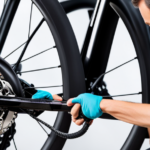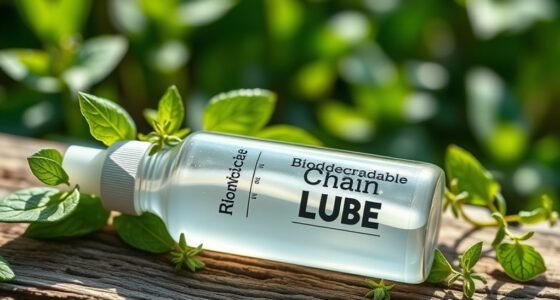To wash your bike water-wise, start by removing loose dirt with a brush or dry cloth, making water use more efficient. Use eco-friendly, biodegradable detergents to clean effectively with less water, focusing on hard-to-reach areas like gears and chains. Control water flow with a low-pressure nozzle and reuse rinse water whenever possible. Dry your bike thoroughly to keep it shiny and explore more sustainable tips to reduce your environmental footprint.
Key Takeaways
- Use eco-friendly biodegradable detergents to clean bikes effectively while minimizing water pollution.
- Implement water recycling techniques like reusing rinse water to reduce overall water consumption.
- Pre-clean with dry brushes or cloth to loosen dirt, decreasing the amount of water needed during washing.
- Control water flow with low-pressure nozzles to prevent wastage and ensure thorough rinsing.
- Collect rainwater or utilize natural water sources for cleaning, promoting sustainable water use practices.

Keeping your bike clean doesn’t have to waste a lot of water. With the right techniques and products, you can maintain a spotless bike while conserving this essential resource. Start by choosing eco friendly detergents that are biodegradable and free from harmful chemicals. These products effectively clean your bike without polluting waterways or harming plants and animals. Using eco friendly detergents means you’re reducing your environmental impact, making your cleaning routine more sustainable.
Next, focus on water recycling techniques to minimize water usage. Instead of letting the rinse water go down the drain, set up a simple system to reuse it. For example, you can direct the rinse water into a container or a small basin, then reuse it for subsequent cleaning steps or to rinse other parts of your bike. This approach markedly cuts down on water waste and allows you to get multiple uses out of a single load of water. You’ll find that with a bit of planning, you can keep your bike sparkling without feeling guilty about excess water consumption.
When washing your bike, start by removing loose dirt and debris with a brush or a dry cloth. This pre-cleaning step reduces the amount of water needed for a thorough wash. Then, apply your eco friendly detergent either directly to the bike or onto a sponge. Use a soft brush or cloth to scrub away grime, paying close attention to hard-to-reach areas like gears and chain links. Because eco friendly detergents are gentle yet effective, you don’t need to use excessive amounts or harsh scrubbing. Rinse with the water you’ve recycled or saved, making sure to wash away all soap residue thoroughly. This ensures your bike isn’t just clean but also free of any leftover chemical traces.
Throughout the process, be mindful of your water flow. Use a low-pressure spray or a handheld nozzle to control the amount of water used, avoiding unnecessary wastage. When finished, dry your bike with a clean cloth; this step prevents water spots and helps maintain the bike’s shine. Additionally, consider setting up a rainwater collection system as an eco-friendly way to gather water for cleaning. This method taps into a natural resource and further reduces reliance on tap water.
Frequently Asked Questions
What Eco-Friendly Cleaning Products Are Best for Bike Washing?
You should choose biodegradable cleaners and natural degreasers for bike washing. These eco-friendly products effectively clean your bike while minimizing environmental impact. Look for options made from plant-based ingredients, as they break down naturally without harming water systems. Avoid harsh chemicals, and always follow the manufacturer’s instructions. Using biodegradable cleaners and natural degreasers guarantees your bike stays spotless and eco-conscious, helping protect the planet with each wash.
How Often Should I Wash My Bike to Maintain Its Condition?
You should wash your bike every few weeks to keep it in top condition. Regular cleaning helps with bike maintenance by removing dirt, grime, and debris that can cause rust or damage. Adjust your cleaning frequency based on how often and where you ride; if you ride in muddy or salty environments, clean it more often. This habit maintains your bike’s performance and prolongs its lifespan.
Can I Wash My Bike Without Using Water at All?
Yes, you can wash your bike without water by using dry cleaning methods or waterless solutions. These products effectively remove dirt and grime without the need for rinsing, making them eco-friendly and convenient. Simply apply the waterless solution to a cloth or sponge, gently wipe down your bike, and then buff it to a shine. This approach keeps your bike clean while conserving water and avoiding messes.
What Are the Risks of Using High-Pressure Water on a Bike?
Using high-pressure water on your bike is like a storm releasing chaos; it risks pressure damage and water intrusion into delicate parts. The force can strip grease, loosen components, or push water into bearings, causing rust and corrosion. You might think you’re cleaning efficiently, but the hidden damage can weaken your bike over time. So, steer clear of high-pressure sprays and opt for gentler cleaning to protect your ride.
How Can I Prevent Water Spots After Washing My Bike?
To prevent water spots after bike cleaning, you should dry your bike thoroughly with a clean microfiber cloth immediately after washing. Using bike cleaning tips like gentle rinsing and avoiding harsh chemicals helps minimize spots. You can also apply a quick detailer or wax as a water spot prevention measure, which creates a protective layer. Remember, the key is to dry quickly and avoid letting water sit on the surface.
Conclusion
By washing your bike water-wise, you help conserve a precious resource—about 70% of the Earth’s surface is water, yet only 3% is fresh, and much of that is inaccessible. Did you know that a typical bike wash can use up to 50 gallons of water? By choosing eco-friendly methods, you’re not just keeping your bike clean; you’re making a big difference for the planet. Every small step counts—so stay water-wise and ride responsibly!
















